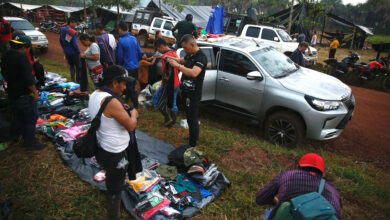Myanmar journalists continue to face persecution year after coup

By Eric San Juan
Ho Chi Minh City, Vietnam, Jan 23 (EFE).- Nearly a year after the military coup in Myanmar, the jailing of two more journalists earlier this week has put the spotlight back on the persecution of journalists in the country, many of whom have been forced into exile or gone into hiding to evade the military junta’s repression.
According to reports, Ko Zaw and Ma Moe Myint, reporters of the digital newspaper Dawei Watch, were arrested from their homes in the southern city of Dawei along with their web designer Ko Thar Gyi on the night of Jan. 18, without the charges against them being made public.
“Myanmar authorities must account for Dawei Watch employees Ko Zaw, Ma Moe Myint, and Ko Thar Gyi, drop any charges against them, and release them immediately. Myanmar’s junta must stop harassing, jailing, and killing journalists,” Shawn Crispin, the Committee to Protect Journalists’ senior Southeast Asia representative, said in a statement.
In its annual report for 2021, the CPJ listed Myanmar as the country with the second highest number of journalists behind bars after China, even though before the coup it did not even appear in the list.
The CPJ has identified 26 journalists who are under the authorities’ custody, apart from around 100 who were arrested at one time or the other during the last 12 months, although the watchdog warned that the situation was “worse” than the numbers suggested.
Many of these reporters have been accused of violating the article 505 (a) of the criminal code, one of the first laws brought by the junta after seizing power, which lays down sentences of up to three years in prison for inciting rebellion or spreading “fake news.”
Analysts have said that the decree was brought in February 2020 as a pretext to arrest journalists at weill, even as arrests have increased in recent months and media houses are being forced to shut down.
Some of the arrests attracted widespread media attention abroad, such as that of United States citizen Danny Fester, a journalist who was released in November following an intense international campaign after having been sentenced to 11 years in prison.
The journalists’ arrest is part of a wider policy of silencing any kind of dissent in the country, which started with the arrest of ousted national leader Aun San Suu Kyi on the day of the coup, Feb. 1, 2021.
According to the Assistance Association for Political Prisoners, 11,665 people have been arrested arbitrarily since the coup, while 1,488 people have been killed in repression by security forces.
These include at least three media professionals according to watchdog Reporters Without Borders (RSF).
The first casualty was photographer Soe Naing, who was killed on Dec. 14, four days after being arrested while taking photos of a silent protest by pro-democracy dissidents in Yangon, the largest city of the country.
Eleven days later, on Christmas the editor of Federal News Journal, Sai Win Aung, was killed in an attack by the military while covering a conflict between the official forces and the People’s Defence Force, the rebel group formed by the opposition.
Another journalist Pu Tuidim, editor of news website Khonumthung Media Group, was killed on Jan. 9 in the conflict-hit Chin province, allegedly kidnapped and executed by military officers after writing an article about soldiers using human shields in clashes with rebels.
The junta’s repression has forced many independent journalists to go into exile or hiding, often in areas controlled by armed dissidents.
Former EFE correspondent Mrat Kyaw Thu had to to leave Yangon last year fearing persecution, and he finally sought political asylum in Spain after spending weeks hiding in the forest.
While digital media outlets are struggling to survive as their journalists hide or flee their cities to protect themselves, the regime’s pressure has led to several print media outlets to shut down, with only pro-junta dailies surviving the unofficial purge. EFE
esj/ia





